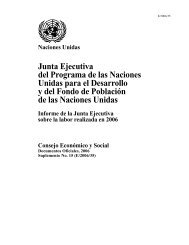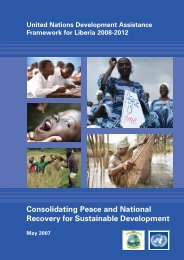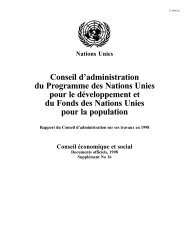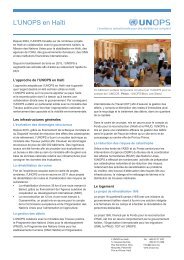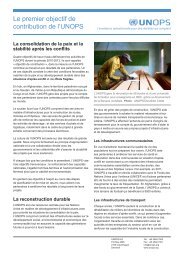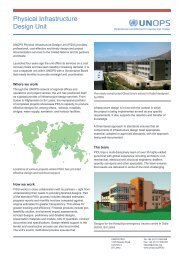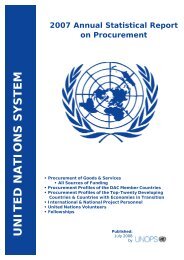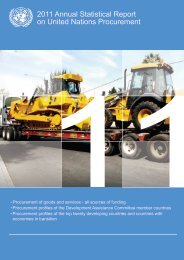India UNDAF 2008-2012 - UNOPS
India UNDAF 2008-2012 - UNOPS
India UNDAF 2008-2012 - UNOPS
You also want an ePaper? Increase the reach of your titles
YUMPU automatically turns print PDFs into web optimized ePapers that Google loves.
<strong>India</strong> <strong>UNDAF</strong> <strong>2008</strong>-<strong>2012</strong><br />
ences. In other cases, they will agree to implement their respective work programmes<br />
separately. In all cases, joint consultation on a quarterly basis, including joint monitoring<br />
according to agreed indicators, will be carried out. At the end of the year, an<br />
assessment will be undertaken and, on the basis of that assessment, plans for the coming<br />
year formulated. The Office of the Resident Co-ordinator will have the responsibility<br />
to track and support this process.<br />
Given the scale and nature of each outcome, collaboration at the Outcome level<br />
will vary.<br />
Outcome 1:<br />
• For many of the national flagship programmes, there are national mechanisms for<br />
coordination under the leadership of the Government of <strong>India</strong>. The UN will participate<br />
fully in these, with the lead agencies on CP outputs co-ordinating the UN’s<br />
input to them. Where mechanisms to facilitate interdepartmental, interagency and<br />
donor coordination do not exist, their establishment will be facilitated as desired<br />
by Government. Such mechanisms will not, however, replace the need for the UN<br />
itself to work together more closely, and have its own structures to do so.<br />
Outcome 2:<br />
• It is recognized that state level coordination mechanisms among UN entities would<br />
have many advantages. While the Country Team has some experience in this, in<br />
both the Tsunami Recovery Programme as well as in the state of Orissa, it is acknowledged<br />
that no one model is yet seen to be ready for widespread adoption. The<br />
Country Team will, therefore, establish two to three different models during this<br />
programme cycle, in order to be able to test and assess success, with a view to wider<br />
adoption.<br />
Outcome 3:<br />
• A joint programme would be established for the implementation of this outcome. It<br />
is anticipated that it will be necessary at the district level in each state to facilitate<br />
coordinated provision of technical and programmatic input. The Country Team will<br />
monitor progress of this project, and serve as its management board.<br />
Outcome 4:<br />
• Coordination for disaster and environmental impact response and preparedness rests<br />
with Central, State and District authorities. Within the UN System, and with its partners<br />
in Government, civil society, and bi-lateral organisations, coordinated action<br />
would happen through the existing, but strengthened mechanism of the UN Disaster<br />
35




